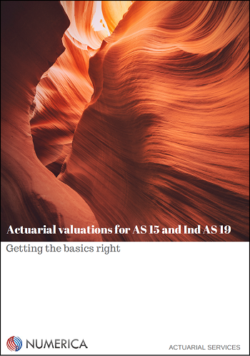
During corporate transactions, such as mergers and acquisition, actuarial valuation of pension and other employee benefit schemes is often ignored. The parties involved in the transaction spend most of their time and focus on ‘tangible’ aspects of the balance sheet. They end up taking ‘shortcuts’ or proxy approaches with disastrous consequences for their shareholders.
I have described the main concepts with reference to a pension scheme. However, the points made are equally applicable to other types of employee benefits, such as gratuity, compensated absences, post-retirement medical benefits etc.
Why do we need an actuarial valuation of pension in mergers and acquisitions?
The objective is to assess a ‘fair value’ as at the date of transaction. A fair value, by definition, is the value at which neither the buyer nor the seller are at a disadvantage. Where it exists, the market value is widely recognised as the fair value.
In case of pension schemes, the liability is not listed on a capital market. Therefore, a fair value has to be derived. This calls for a special actuarial valuation, which aims to replicate the market value of pension scheme liabilities. Such a valuation is called a market-consistent valuation. You can get more information about these valuations here.
Why can’t we use other types of actuarial valuations?
Actuarial valuation for accounting, such as IAS 19, Ind AS 19, AS 15 etc., do not attempt to replicate the market values. Therefore, there use will inevitably lead to a wrong transaction price to be calculated. Several organisations have learned this the hard way.
Actuarial valuation for accounting is performed as per the rules prescribed in the accounting standard. The rules have been designed for ‘comparability’ between companies and therefore apply to the industry as a whole. Instead, the transaction price should be arrived at by considering all available information specific for the pension or benefit scheme being transferred.
Similarly, funding valuations may incorporate a high degree of prudence in the actuarial valuation. Therefore, it will not reflect the fair value of the pension scheme liability.
How to perform a market-consistent actuarial valuation?
The starting point will be the same as a regular actuarial valuation; i.e. projecting and discounting the cashflows using Projected Unit method. However, there will be some special considerations, as explained below.
-
Use of risk-free interest rates
The valuation should involve the use of risk-free interest rates. This is perhaps the most significant difference. These rates must allow for the full term structure of interest rates, rather than a single discount rate. This will require construction of the complete yield curve based on the market prices of traded government bonds as at the date of transaction. Refer to this post which explains the process of construction of yield curves.
(Edited 29.1.18) For completeness, it is worth pointing out that in some situations we can increase the risk-free rates by a small amount, called illiquidity premium. Allowing for illiquidity premium in the discount rate would lead to a lower liability value. Alternatively, we can perform a full asset-liability analysis which is likely to reduce the liability further due to offsetting impact of ‘matching adjustment’ (as defined in Solvency II). The concepts of illiquidity premium and matching adjustment are more relevant to long-dated liabilities (i.e. pensions) and quite complex. This post is limited to providing an overview of market-consistent valuation approach for the benefit of accountants and pension professionals. Therefore, they are not discussed further in this post.
Accounting valuations do not utilise the term structure. Most accounting standards prescribe a single value for discount rate, which is applied to discount all cashflows, irrespective of their duration. Furthermore, the accounting standards allow using a higher discount rate than the risk-free rate. Therefore, the accounting valuation could lead to a fair value quite different from the fair value.
-
Use of risk margin
Certain actuarial assumptions will not be set to their best estimate values, as required by the accounting standards. Explicit margins will need to be allowed for. For example, if the best estimate attrition assumption is 10%, we could use a value of 12%, if that increases the liability.
This margin is similar to a prudential margin in funding valuation. However, there is one important distinction. While the prudential margin is a ‘buffer’ against adverse deviation, the margin in a market-consistent valuation represents the ‘price of risk’, as described next.
In a merger or acquisition, the final cost to the buyer of a pension liability is uncertain. Actuaries make assumption about future events, but in all likelihood, the actual experience could turn out to be worse than expected. This could cause a loss to the buyer.
Therefore, the buyer needs to be ‘compensated’ for taking on the risk, in addition to the ‘best-estimate’ present value of the future cashflows. This extra compensation is provided by using slightly assumptions that are slightly worse than the best-estimate assumptions. Refer to this post to learn more.
-
Use of stochastic models
Several pension schemes have embedded guarantees. Generally, these are minimum return guarantees, or some ‘underpins’, where the final benefit to a pensioner is the higher of two separate benefit rules.
Calculation of fair value will require these guarantees to be calculated separately and explicitly using stochastic methods. Cost of these guarantees to the buyer could be substantial.
What are other actuarial issues to consider during mergers and acquisitions?
Both parties should consider a range of other actuarial issues in corporate transactions. Some of them are listed below, but will be described in detail in later posts:
- Due diligence of leave schemes (compensated absences). More specifically, the First-In-First-Out (FIFO) method could be more suitable.
- Consider benefits which may not under the scope of the applicable accounting standards, but may still represent a cost to the buyer in future. An example is loan to employees.
- For share-based benefit schemes, such as ESOPs and SARs, a fresh valuation may be required as at the date of transaction. The carrying value, which is the un-amortised value of value as at the date of grant, may not represent the true market value.
Learn about the basics of actuarial valuation of employee benefits:

